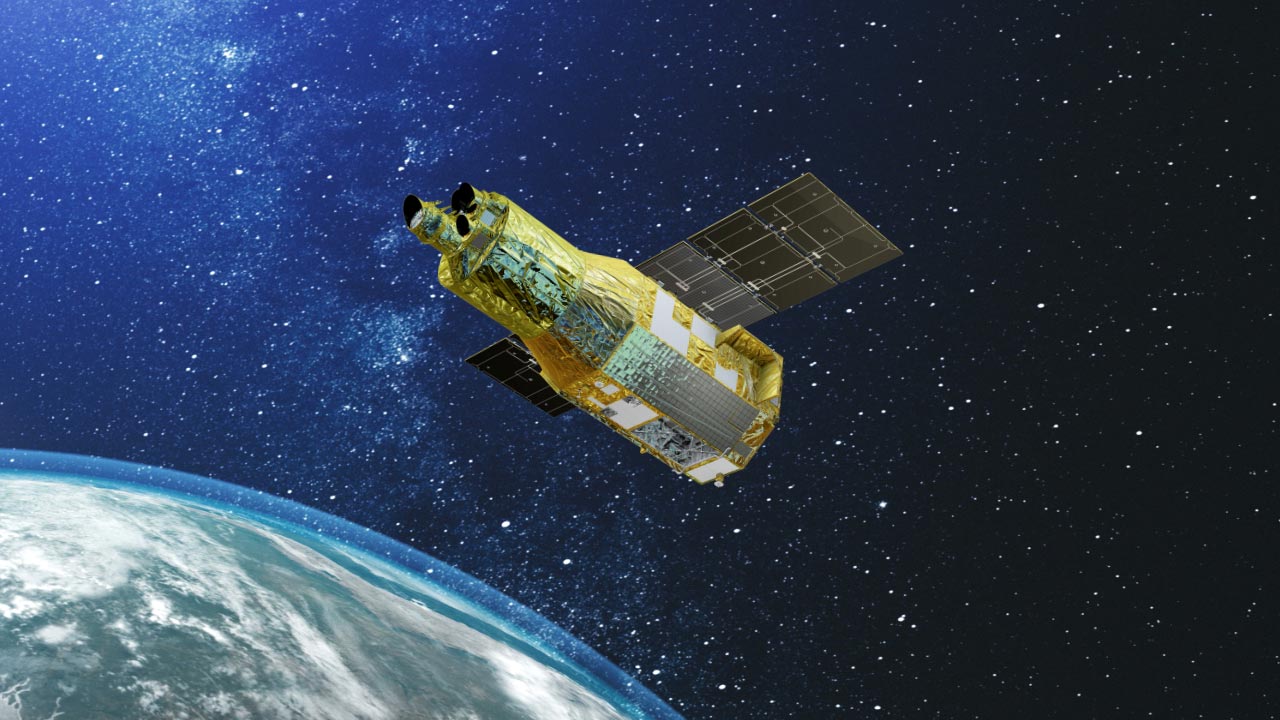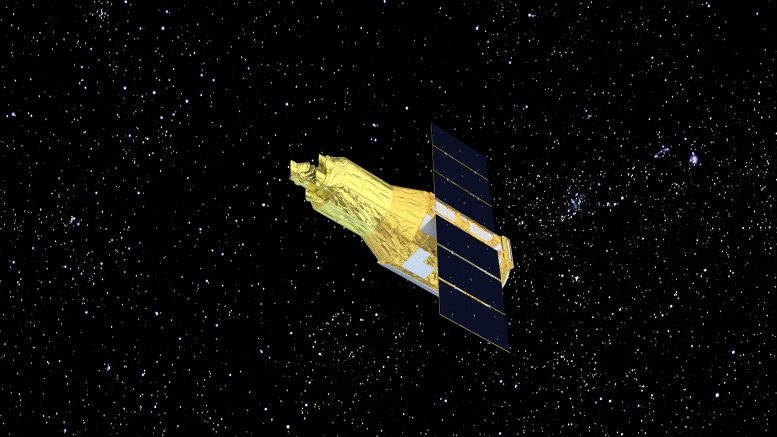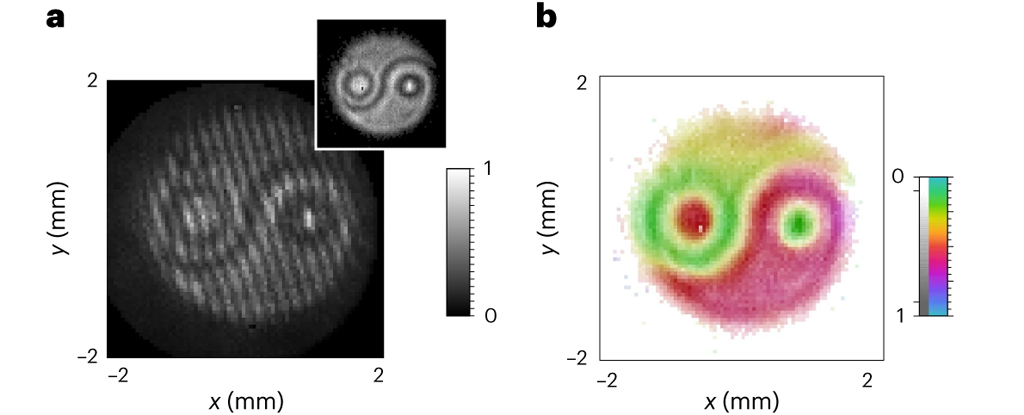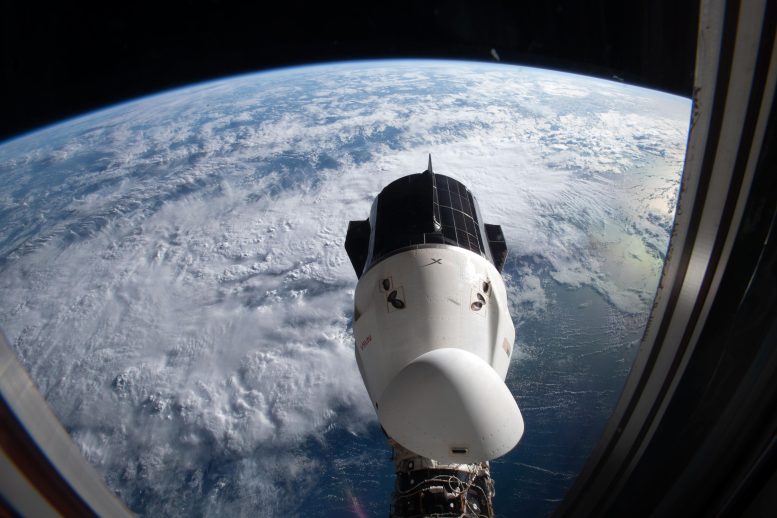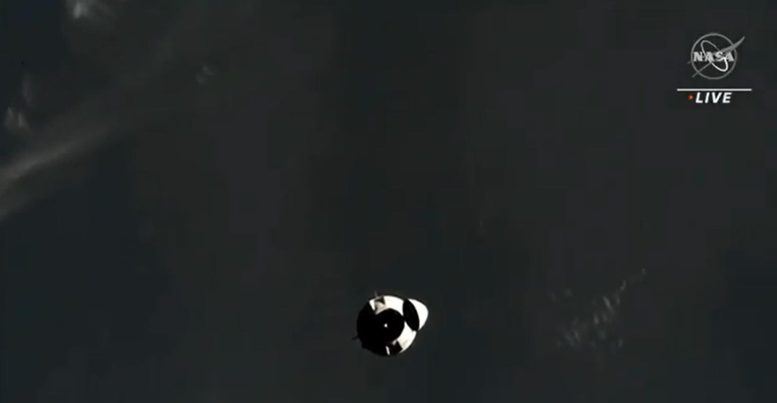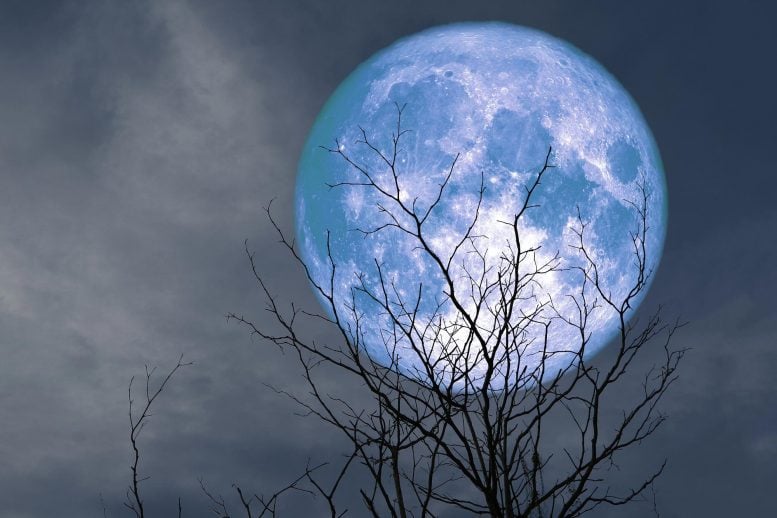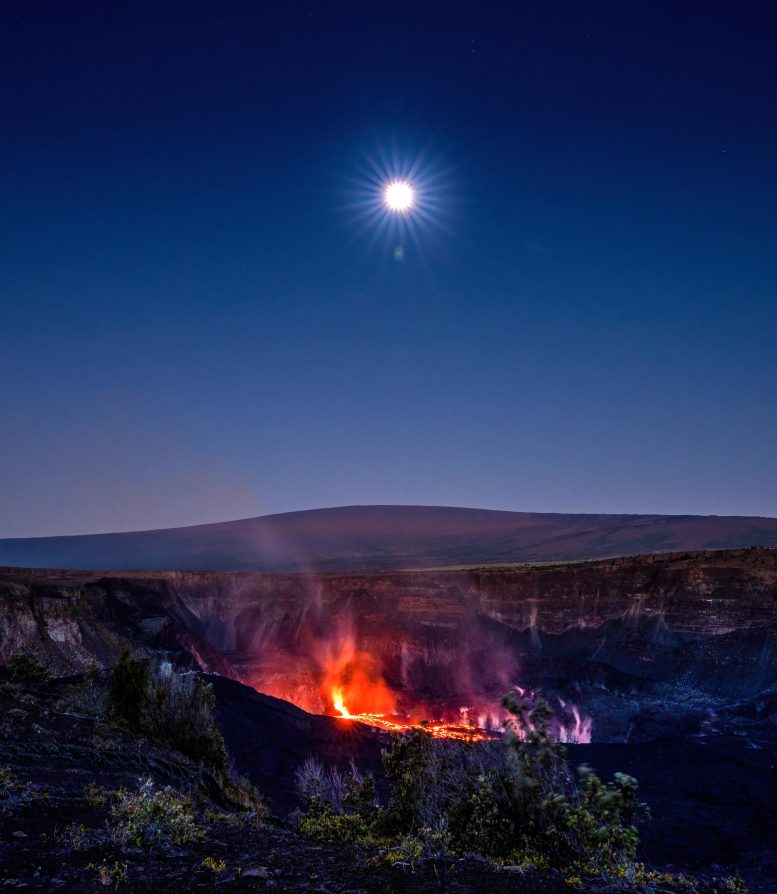
The Moon of August 30-31, 2023, is a full moon, a supermoon, and finally a blue moon. Therefore, you’ll hear it referred to as a super blue moon as a result. Note that a “Blue Moon” has nothing to do with its color. Photographers often use filters and other techniques to capture beautiful images of the full moon in blue or other colors.
The Next Full Moon is a Supermoon, a Blue Moon, and Rakhi Purnima.
The next full Moon will be Wednesday night, August 30, 2023, appearing opposite the Sun (in Earth-based longitude) at 9:36 p.m. EDT. The planet Saturn, just a few days from its closest and brightest for the year, will appear near the Moon. As evening twilight ends (at 8:42 p.m.) Saturn will be 5 degrees to the upper right of the Moon, and will appear to swing clockwise around the Moon as the evening progresses. The Moon will appear full for 3 days around the peak of the full Moon, from Tuesday night to Friday morning.
This will be a supermoon. Publications use different thresholds for deciding which Moons qualify as “super,” but all agree that in 2023 the two full Moons in August qualify.
Have questions? See the Super Blue Moon FAQ.
This full Moon will be the second full Moon in August, making it a Blue Moon by the newer definition introduced by Sky & Telescope magazine in 1946. The older definition of Blue Moon, dating back to at least the 1500s, is the name for the third full Moon in a season that has four Moons. By this definition, the full Moon in August 2024 will be the Blue Moon and this full Moon, as the last full Moon of summer, shares some of the seasonal names from my posting for the August 1 full Moon. Neither of these definitions has anything to do with the color of the Moon, so the Blue Moon will not actually look blue. See this article to learn about a time when the Moon actually turned blue!

A full moon rises over an active caldera in Hawaii Volcanoes National Park. Credit: National Park Service/Janice Wei
This full Moon corresponds with the Hindu festival Raksha Bandhan, also called Rakhi or Rakhi Purnima, celebrating the bond between brothers and sisters. One of the traditions is for sisters of all ages to tie a rakhi (a cotton bracelet) around their brother’s wrist, receiving a gift from the brother in return, as a sign of the continuing bond between them. The term “Raksha Bandhan” translates as “the bond of protection, obligation, or care.”
In many traditional lunisolar and lunar calendars the full Moons fall near the middle of the lunar months. This full Moon is in the middle of the seventh month of the Chinese calendar, Safar in the Islamic calendar, and Elul in the Hebrew calendar. Elul is a time of preparation for the High Holy Days of Rosh Hashanah and Yom Kippur. Customs include granting and asking others for forgiveness as well as beginning or ending all letters with the wish that the recipient will have a good year.
As usual, the wearing of suitably celebratory celestial attire is encouraged in honor of the full Moon. Take care of your siblings, let go of grudges, and here’s wishing you a good year!
As for other celestial events between now and the full Moon after next (with specific times and angles based on the location of NASA Headquarters in Washington, DC):
As summer ends and fall begins, the daily periods of sunlight continue to shorten, changing at their fastest around the autumnal equinox.
On Wednesday, August 30, 2023 (the day of the full Moon), morning twilight will begin at 5:35 a.m. EDT, sunrise will be at 6:35 a.m., solar noon will be at 1:09 p.m. when the Sun will reach its maximum altitude of 60.0 degrees, sunset will be at 7:42 p.m., and evening twilight will end at 8:42 p.m.. The autumn equinox will be on Saturday, September 23, with sunrise at 6:57 a.m. and sunset at 7:04 p.m.. By Friday, September 29 (the day of the full Moon after next), morning twilight will begin at 6:04 a.m., sunrise will be at 7:02 a.m., solar noon will be at 12:58 p.m. when the Sun will reach its maximum altitude of 48.6 degrees, sunset will be at 6:54 p.m., and evening twilight will end at 7:52 p.m..
No major meteor showers are predicted to peak during this lunar cycle. Three minor showers will peak at 6 or fewer visible meteors per hour under ideal conditions (effectively not visible from our brightly lit urban environments).
Evening Sky Highlights:
On the evening of Wednesday, August 30, 2023 (the night of the full Moon), as evening twilight ends (at 8:42 p.m. EDT), the rising Moon will be 8 degrees above the east-southeastern horizon with the planet Saturn 5 degrees to the upper right. The planet Mars will be setting on the western horizon. The bright star appearing closest to overhead will be Vega at 85 degrees above the eastern horizon. Vega, the brightest star in the constellation Lyra the lyre, is one of the three bright stars in the Summer Triangle (along with Deneb and Altair). Vega is the 5th brightest star in our night sky, about 25 light-years from Earth, has twice the mass of our Sun, and shines 40 times brighter than our Sun.
As this lunar cycle progresses, the background of stars and the planet Saturn will appear to shift westward each evening (as the Earth moves around the Sun), while the planet Mars will shift more slowly on the western horizon. After September 1 Mars will be below the horizon as evening twilight ends. The waxing Moon will pass by Spica on September 17 (hard to see as they will set shortly after evening twilight ends), Antares on September 20, and Saturn on September 26.
By the evening of Thursday, September 28 (the start of the night of the full Moon after next), as evening twilight ends (at 7:53 p.m. EDT), the rising Moon will be 12 degrees above the east-southeastern horizon. The planet Saturn will be 23 degrees above the southeastern horizon. The bright star appearing closest to overhead still will be Vega at 83 degrees above the western horizon.
Morning Sky Highlights:
On the morning of Thursday, August 31, 2023 (the morning of the night of the full Moon), as morning twilight begins (at 5:36 a.m. EDT), the setting Moon will be 14 degrees above the west-southwestern horizon. The planet Saturn will be to the lower right of the Moon at 7 degrees above the west-southwestern horizon. The other two visible planets will be bright Jupiter at 66 degrees above the southern horizon and even brighter Venus at 9 degrees above the eastern horizon. At 66 degrees Jupiter will be the bright object closest to overhead (with the bright star Capella a close second at 65 degrees above the east-northeastern horizon).
As this lunar cycle progresses, Venus, Jupiter, Saturn, and the background of stars will appear to shift westward each evening. September 8 will be the last morning Saturn will be in the sky as morning twilight begins. Beginning September 14, Mercury will rise before morning twilight begins, joining Venus and Saturn. Initially, Mercury will be difficult to see but will brighten quickly each morning. Venus will reach its greatest brilliancy on September 19 (when Venus is near its brightest it can be seen in the daytime). Mercury will reach its greatest angular separation from the Sun on September 22 and will appear at its highest above the horizon as morning twilight begins the next morning, September 23. The waning Moon will pass near Jupiter on September 4, Pollux on September 10, Venus on September 11 and 12, and Regulus on September 13.
On the morning of Friday, September 29, (the morning of the full Moon after next), as morning twilight begins (at 6:04 a.m. EDT), the setting full Moon will be 11 degrees above the western horizon. The three visible planets will be Venus (the brightest) at 29 degrees above the eastern horizon, Jupiter at 48 degrees above the west-southwestern horizon, and Mercury (the faintest) at 4 degrees above the eastern horizon. The bright star appearing closest to overhead will be Capella at 83 degrees above the north-northwestern horizon). Capella is the brightest star in the constellation Auriga the charioteer. Although we see Capella as a single star (the 6th brightest in our night sky), it is actually four stars (two pairs of stars orbiting each other). Capella is about 43 lightyears from us.
Detailed Daily Guide:
Here for your reference is a day-by-day listing of celestial events between now and the full Moon after next. The times and angles are based on the location of NASA Headquarters in Washington, DC, and some of these details may differ for your location (I use parentheses to indicate times specific to the DC area).
On Thursday night, August 24, 2023, the bright star Antares will appear near the half-full Moon, so close that for much of Canada, the US, and northern Mexico the Moon will pass in front of Antares. For the Washington, DC area, as evening twilight ends (at 8:52 p.m. EDT), Antares will be a degree to the left of the Moon. Antares will disappear behind the dark side of the Moon about an hour later (at 10:53 p.m.). Antares will reappear from the bottom of the Moon about 45 minutes after that (around 11:41 p.m.) but the bright limb of the Moon will at first mask this reappearance. Antares will set first on the west-southwestern horizon about 14 minutes later (at 11:55 p.m.). See this data for details on this occultation for your area.
Saturday morning, August 27, 2023, the planet Saturn will be at its closest and brightest for the year, called “opposition” because it will be opposite the Earth from the Sun, effectively a “full” Saturn. Saturn will be 10 degrees above the east-southeastern horizon as evening twilight ends Friday, August 26 (at 8:48 p.m. EDT), will reach its highest in the sky early Saturday morning (at 1:13 a.m.), and will be 11 degrees above the west-southwestern horizon as morning twilight begins (at 5:32 a.m.). Only planets that orbit farther from the Sun than the Earth can be seen at opposition from the Earth.
Wednesday morning, August 30, 2023, at 11:55 a.m. EDT, the Moon will be at perigee, its closest to the Earth for this orbit.
Wednesday night into Thursday morning, August 30 to 31, 2023, the planet Saturn, just a few days from its closest and brightest for the year, will appear near the full supermoon. As evening twilight ends (at 8:42 p.m. EDT), the Moon will be 8 degrees above the east-southeastern horizon with Saturn 5 degrees to the upper right. Saturn will appear to shift clockwise around the Moon as the night progresses. The Moon will reach its highest in the sky 4.5 hours later (Thursday morning at 1:23 a.m.) with Saturn 7 degrees to the right. By the time morning twilight begins (at 5:36 a.m.) the Moon will be 14 degrees above the west-southwestern horizon with Saturn 8 degrees to the lower right.
As mentioned above, the next full Moon will be Wednesday night, August 30, 2023, appearing opposite the Sun (in Earth-based longitude) at 9:36 p.m. EDT. The Moon will appear full for 3 days around the time of the full Moon, from Tuesday night to Friday morning. This full Moon will be the second full Moon in August, making it a Blue Moon by the newer definition introduced by Sky & Telescope magazine in 1946. Since this full Moon occurs near when the Moon is closest to the Earth (perigee), this will be a supermoon.
Friday evening, September 1, 2023, will be the last evening that the planet Mars will be above the western horizon as evening twilight ends (at 8:38 p.m. EDT), setting a minute later.
Sunday night into Monday morning, September 3 to 4, 2023, the planet Jupiter will appear near the waning gibbous Moon. As Jupiter rises above the east-northeastern horizon (at 10:16 p.m. EDT) it will be 8 degrees to the lower left of the Moon. The Moon will reach its highest in the sky for the night 6.5 hours later (at 4:45 a.m.) with Jupiter 6 degrees to the left of the Moon. Morning twilight will begin about an hour later (at 5:40 a.m.).
By Monday evening, September 4, 2023, the waning gibbous Moon will have shifted to the other side of Jupiter. As the Moon rises on the east-northeastern horizon (at 10:14 p.m. EDT) Jupiter will be 6 degrees to the right. The pair will separate as the night progresses.
Wednesday morning, September 6, 2023, the planet Mercury will be passing between the Earth and the Sun as seen from the Earth, called inferior conjunction. Planets that orbit inside of the orbit of Earth can have two types of conjunctions with the Sun, inferior (when passing between the Earth and the Sun) and superior (when passing on the far side of the Sun). Mercury will be shifting from the evening sky to the morning sky and will begin emerging from the glow of dawn on the eastern horizon in mid-September (depending upon viewing conditions).
Wednesday evening, September 6, 2023, the waning Moon will appear half-full as it reaches its last quarter at 6:21 p.m. EDT.
Friday morning, September 8, 2023, will be the last morning that the planet Saturn will be above the horizon as morning twilight begins.
Sunday morning, September 10, 2023, the bright star Pollux will appear above the waning crescent Moon. As the Moon rises on the northeastern horizon (at 2:10 a.m. EDT) Pollux will be 3 degrees above the Moon. Bright Venus will rise on the east-northeastern horizon 2 hours later (at 4:07 a.m.), appearing about 20 degrees below the Moon, with Pollux 4 degrees above the Moon. By the time morning twilight begins 1.5 hours after that (at 5:46 a.m.), Pollux will have shifted to 5 degrees above the Moon with Venus 19 degrees below the Moon. The bright star Regulus will be 18 degrees to the lower left of Venus.
Monday morning, September 11, 2023, the thin, waning crescent Moon will have shifted to 12 degrees to the upper left of Venus.
Tuesday morning, September 12, 2023, the thin, waning crescent Moon will have shifted to 13 degrees to the lower left of Venus, with the bright star Regulus 10 degrees below the Moon.
Tuesday mid-day, September 12, 2023, at 11:43 a.m. EDT, the Moon will be at apogee, its farthest from the Earth for this orbit.
Wednesday morning, September 13, 2023, the bright star Regulus will be 5 degrees to the right of the very thin, waning crescent Moon. The planet Mercury will be 8 degrees to the lower right of the Moon, but will be difficult to see, as it will rise a few minutes after morning twilight begins and will not be very bright (a crescent that is only 11% illuminated).
Thursday morning, September 14, 2023, will be the first morning the planet Mercury will be above the horizon as morning twilight begins. It will be difficult to see at first, only 14% illuminated, but will brighten each morning as the Sun illuminates more of its Earth-facing surface.
Thursday night, September 14, 2023, at 9:40 p.m. EDT, will be the new Moon, when the Moon passes between the Earth and the Sun and will not be visible from the Earth. The day of or the day after the New Moon marks the start of the new month for many lunisolar calendars. The eighth month of the Chinese calendar will start on September 15.
Sundown on Friday, September 15, 2023, will be the start of Rosh Hashanah (the Head of the Year), the two-day Jewish New Year celebration that will end at sundown on Sunday, September 17. Rosh Hashanah is the first of a series of holidays in Tishrei, the first month of the Hebrew calendar. The tenth day of Tishrei is Yom Kippur, the Day of Atonement. The 10 days from Rosh Hashanah to Yom Kippur, called the Days of Awe, are a time to reflect on the mistakes and lessons of the past, and to make resolutions for the new year. The fifteenth day of Tishrei (close to the full Moon after next) is the start of the 7-day Sukkot holiday.
In the Islamic calendar, the months traditionally start with the first sighting of the waxing crescent Moon. Many Muslim communities now follow the Umm al-Qura Calendar of Saudi Arabia, which uses astronomical calculations to start months in a more predictable way. Using this calendar, sundown on Friday evening, September 15, 2023, will probably mark the beginning of Rabi’ al-Awwal, the third month of the Islamic calendar. During this month some Muslims celebrate Mawlid, the birthday of Muhammad.
Sunday evening, September 17, 2023, if you have a very clear view of the west-southwestern horizon, you might be able to see the bright star Spica 3 degrees to the lower right of the thin, waxing crescent Moon. They may be difficult to see. You would need to look before evening twilight ends, as when twilight ends (at 8:11 p.m. EDT) Spica will be close to setting and the Moon will be only 2 degrees above the horizon. The Moon will set 17 minutes later (at 8:28 p.m.).
Solar noon to solar noon from Monday, September 18, to Tuesday, September 19, 2023, will be the shortest solar day of the year. At 23 hours, 59 minutes, 38.6 seconds long, it will be 21.4 seconds shorter than the 24 hour average our modern clocks use.
On Tuesday, September 19, 2023, the planet Venus will be at its greatest brilliancy for the year, a good estimate of when Venus will be at its brightest. Greatest brilliancy is calculated based on the distances and angles between the Sun, Venus, and the Earth, making a simplifying assumption on how Venus scatters sunlight. When bright, Venus can be seen during the day (if the skies are clear enough and you know where to look). Greatest brilliancy occurs about 36 days before and after inferior conjunction.
On Wednesday evening, September 20, 2023, the bright star Antares will appear to the upper left of the waxing crescent Moon. Antares will be 5 degrees from the Moon as evening twilight ends (at 8:06 p.m. EDT). By the time the Moon sets on the west-northwestern horizon less than 2 hours later (at 9:57 p.m.) Antares will be 4 degrees from the Moon. For parts of East Asia the Moon will actually pass in front of Antares, blocking it from view (see https://ift.tt/fbSzyUe for more information).
By Thursday evening, September 21, 2023, as evening twilight ends, the Moon will have shifted to 8 degrees on the other side of Antares. The pair will separate as the evening progresses.
Friday morning, September 22, 2023, will be when the planet Mercury reaches its greatest angular separation from the Sun as seen from the Earth for this apparition (called greatest elongation). Because the angle of the line between the Sun and Mercury and the horizon changes with the seasons, the date when Mercury and the Sun appear farthest apart as seen from the Earth is not always the same as when Mercury appears highest above the eastern horizon as morning twilight begins, which occurs the next morning, Saturday, September 23.
On Friday afternoon, September 22, 2023, the Moon will appear half-full as it reaches its first quarter at 3:32 p.m. EDT.
Early Saturday morning, September 23, 2023, at 2:50 a.m. EDT, will be the autumnal equinox, the astronomical end of summer and start of fall. The Sun will be shifting from the Northern to the Southern Hemisphere, this year passing across the Earth’s equator over the Indian Ocean.
On Sunday, September 24, 2023, a mission I worked on before retiring from NASA, OSIRIS-REx, will deliver to Earth a sample from the surface of the asteroid Bennu. NASA’s Live coverage of the capsule landing is scheduled to start at 10 a.m. EDT.
Tuesday evening into Wednesday morning, September 26 to 27, 2023, the planet Saturn will appear near the waxing gibbous Moon. Saturn will be 4 degrees to the upper left of the Moon as evening twilight ends (at 7:56 p.m. EDT). By the time the Moon reaches its highest in the sky for the night a little over 3 hours later (at 11:07 p.m.) Saturn will be 3 degrees to the upper right. As Saturn sets below the west-southwestern horizon a little over 5 hours after that (at 4:24 a.m.) it will be 4 degrees to the lower right of the Moon.
Wednesday evening, September 27, 2023, at 9:06 p.m. EDT, the Moon will be at perigee, its closest to the Earth for this orbit.
The full Moon after next will be Friday morning, September 29, 2023, appearing opposite the Sun (in Earth-based longitude) at 5:58 a.m. EDT. This will be late Thursday night from the time zone of Hawaii and the Cook Islands westward to the International Date Line. The Moon will appear full for 3 days around this time, from Wednesday evening to Saturday morning.
Adblock test (Why?)
Article From & Read More ( Don't Miss: Super Blue Moon - SciTechDaily )
https://ift.tt/tuWIhyb
Science



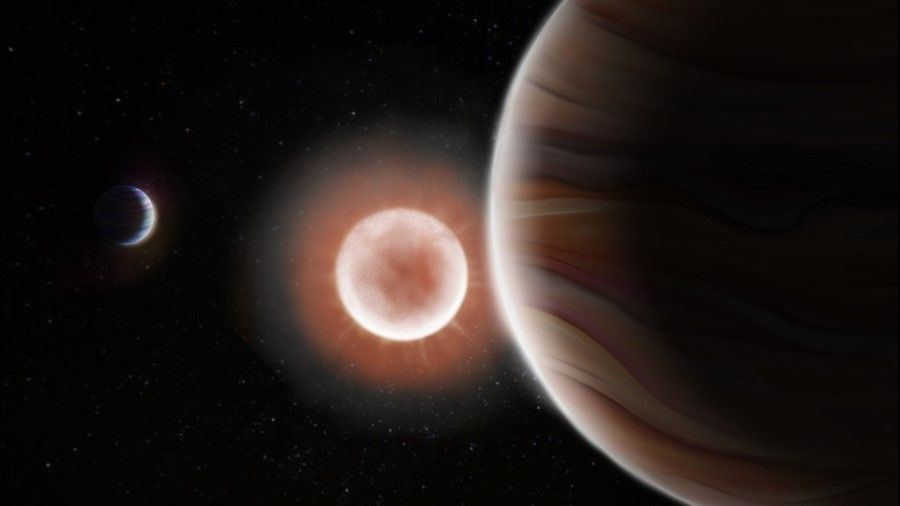




/cloudfront-us-east-2.images.arcpublishing.com/reuters/CX6IDBDRWRKGJDDHV7UVRLFSCE.jpg)
